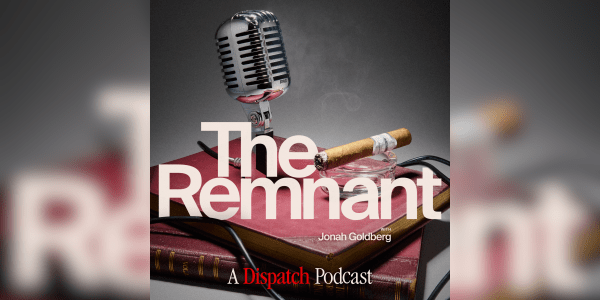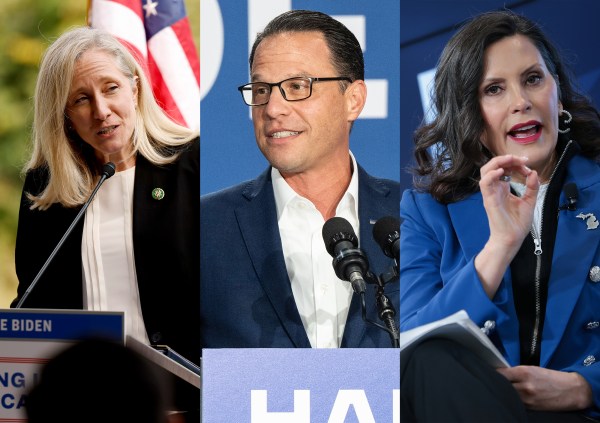America is never more hopeless than in the hours after a lunatic goes postal.
The first wave of hopelessness hits when you learn the details, the second when left and right come out of their corners throwing roundhouses in hopes of making those details as damning or innocuous for their side as circumstances require. If you’re foolish enough to participate in political social media, as I am, you know platforms reach peak toxicity at times like these.
Mass shootings are the supreme example. The talking points on gun control for the two sides are so well-worn after so many massacres that one could generate templates or script code for the next incident, with only the city needing to be filled in. Thoughts and prayers; complaints that “thoughts and prayers” are a hollow substitute for regulation; reminders that mass shootings are a tiny percentage of gun homicides; counterpoints that banning AR-15s would at least deprive spree killers of their favorite weapon; counter-counterpoints that there are too many in circulation to ban and that nearly everyone who owns one is law-abiding, etc, etc.
If you want to watch Americans talk completely past each other and make not even a pretense of behaving like normal human beings in the rush to don their partisan armor, boot up the ol’ Twitter machine during breaking coverage of a mass shooting. That’s hopelessness.
For years I analogized how partisans react on social media during those incidents to how PR flacks behave. If you work in public relations and your client is beset by a fast-moving scandal, your professional obligation requires you to put aside personal feelings and focus on minimizing the damage to his image. (Hi, Kanye publicists!) Lately, though, I’ve come to think my colleague David French is closer to the truth when he says partisans on social media behave more like lawyers. It’s a better metaphor because the fervor with which they serve their “client” after a mass shooting implies a higher sense of duty than what a publicist might feel. Lawyers fight for their client’s liberty, after all, not just their reputation. And they do so within an aggressively adversarial process, a trial, where there’s a discrete winner and loser. The stakes are higher and more directly confrontational than with PR.
Elon Musk has compared Twitter to the public square but the political side of it is more like a courtroom, particularly when emotions run hot at a moment of high partisan salience. Terrible news breaks; the “jury” is impaneled as Americans of all stripes put aside what they’re doing to follow the coverage; the “lawyers” from both sides immediately get to work.
It’s the worst, a recurring reminder that the country’s politics are so paralyzed that even the reaction to catastrophes will fall predictably along partisan lines. And it happened again this weekend after Nancy Pelosi’s husband, Paul, was attacked by an intruder in their home in San Francisco.
Rather than repeat the facts in detail, I’ll trust that you’ve read Declan Garvey’s and Esther Eaton’s summary of what we know about the assault in The Morning Dispatch. Briefly, a local nut broke into the Pelosi home looking for Nancy but encountered Paul Pelosi instead. Pelosi managed to phone the police but the suspect attacked him with a hammer moments before the cops arrived, sending him to the hospital.
The fact that a prominent Democrat was victimized made the partisan roles in this case easy. Liberals would be doing the “prosecuting” while conservatives would represent the “defense.”
The prosecution’s job in any instance of political violence is straightforward, to show that the assailant’s crime was incited to some greater or lesser degree by the other party. Whether the attacker voted right-wing, admired right-wingers, or consumed right-wing media, liberals online scrambled to show that ultimate responsibility for the attempted murder of Nancy Pelosi’s husband lay collectively at the feet of the mainstream American right.
The juiciest news on that point comes from blog posts apparently written this summer by the assailant. In Garvey’s and Eaton’s words, those posts focused on “Jews, the media, black and transgender people, Democrats, pedophiles, public health officials, etc. He expressed support for Donald Trump and his claims of a stolen 2020 election, but he also wrote often about an ‘invisible fairy’ that would occasionally transform into a bird and visit him.” He referenced QAnon as well. Go figure that someone who’s deep in the weeds of right-wing conspiracy media would viscerally hate Nancy Pelosi.
With the left’s “lawyers” having established prima facie that there was a political motive in targeting her, it fell to the right’s “lawyers” to present a defense. Or several defenses, actually. Which one different conservatives chose to present depended on how fervently populist their politics is. Let’s take them from least to most fervent.
1. “The attacker was crazy and/or left-wing, not political.” There’s truth to this, per the note about the “invisible fairy” above. Based on the biographical sketches hastily assembled by the media this weekend, Pelosi’s attacker has been plainly disturbed for years and used to align culturally more with the left (he was a “hemp jewelry maker” and pro-nudity activist at one point) than the right. Liberals have also been known to jump to conclusions about political motives for violence in the past where none exist. Their lie that the man who shot Gabby Giffords in 2011 was inspired by Tea Party rhetoric proved so durable that Sarah Palin was still trying to correct the record about it more than a decade later.
But insanity and political motive aren’t mutually exclusive. It’s true that “January 6 Did Not Attack Paul Pelosi” yet also true that a man prone to delusion seems to have been influenced by collective delusions propagated by right-wingers. On any given day, you might find the once and future president of the United States retweeting QAnon accounts on Truth Social. And those delusions aren’t harmless: QAnoners fantasize about seeing their political opponents arrested en masse and executed for preying on children. One adherent killed his wife and shot his daughter last month. Insane beliefs have never been more mainstream and accessible within the American right in my lifetime than they are right now. And the more mainstream they are, the more people who might be prone to violence are stumbling across them.
It’s possible, maybe likely, that the nut who attacked Paul Pelosi was destined to attack someone. But it may also be that the political media he consumed got him to thinking about who, specifically, that someone should be.
2. “But the media.” This is always the preferred defense of respectable partisan Republicans to political violence that’s being blamed on the right. They’re too decent to celebrate the violence and too sane to push conspiracy theories that try to shift blame for the attack, but they’re still obliged by partisan duty to be lawyers for their side. A tried and true strategy is to change the subject by pounding the table about the media, specifically the double standard practiced by which all political violence perpetrated by lefties are isolated incidents whereas all political violence perpetrated by righties are products of a culture of incitement.
And, well, they’re correct. There is a double standard. And it’s egregious.
Examples are so numerous that if you asked 10 different conservatives to name one you might get 10 different answers. For me, the ne plus ultra will forever be the low-key media reaction to the near-massacre of Republican congressmen by a Bernie-Sanders-loving lunatic five years ago. That story was covered, of course, but without the “culture of hate” heavy breathing that would have adorned every article about it if the partisan roles had been reversed.
No need to stop there, though. The riots after George Floyd’s death, the vandalism of crisis pregnancy centers and churches earlier this year, the aborted assassination attempt on Brett Kavanaugh—all of these were noted by assorted media outlets but seldom if ever incorporated into a damning narrative about left-wing incitement. Which stands to reason: Since so many journalists lean left, they naturally find themselves in the “defense” role when a left-winger assails someone.
So the “but the media” argument is a fair cop. But it’s also a cop out inasmuch as those who use it will never reckon seriously with the faults of their own side. Any occasion that might lead them to consider whether, perhaps, cranks have gotten a bit too much traction in right-wing media and the Republican establishment will lead to them whatabouting the left to avoid any internecine confrontations. As a “lawyer” for their side, their first duty will always be to their client, the party.
3. “It’s a conspiracy.” Here’s where we separate the men from the boys.
It occurs to me that we’ve reached the point where there’s no setback the populist right might suffer that they won’t attempt to explain away as a conspiracy. Before the votes were even fully counted in Sunday’s Brazilian presidential election, Steve Bannon was screeching that Jair Bolsonaro had been cheated. There’s a straight line between that logic and Trump’s “stop the steal” effort in 2020, of course. It’s a devotee’s belief that populist authoritarianism can’t possibly be defeated legitimately at the polls. It’s the people’s choice. If a strongman loses, he’s necessarily been cheated.
That’s how all conspiracy theories work, right? Something happens that makes reality too unpleasant or chaotic for comfort, so people invent an explanation that restores order to the universe as they’ve understood it.
That logic isn’t limited to enormous defeats like losing presidential elections, though. It also works with small defeats like the husband of the Democratic speaker of the House being assaulted by someone who seems to have taken inspiration from right-wing media. It’s how a fundamentalist copes with embarrassment. If righty populism is the way, the truth, and the light, then all bad outcomes attributable to it must actually be attributable to other unseen causes.
Which is how we ended up with this post from the son of a former president.
If you don’t understand why Junior is posting photos of hammers and underwear, go read Gizmodo’s round-up of seven (seven!) different conspiracy theories that sprang up in the hours after the Pelosi news broke. Reports circulated initially that the attacker had been found in his underwear and that Paul Pelosi had described him as a “friend.” Both turned out to be untrue but that was enough to ignite a theory that Pelosi and the attacker had been engaged in a tryst that had somehow gone bad.
A theory that was shared by, among other people, a sitting Republican congressman. And the new owner of Twitter, the world’s richest man.
He deleted it later, but screenshots live forever.
In the FBI affidavit filed Monday, the suspect makes clear that nothing of the sort happened. He broke into the home and found a “surprised” Paul Pelosi in bed. His hope, he said, was to hold Nancy Pelosi hostage until she admitted “the truth” and to break her kneecaps if she didn’t.
Populists liked the “gay prostitute” theory for two reasons, though, one of which was the sheer cruelty of it. The idea that Paul Pelosi is secretly what some of these people would call a “sissy,” that he’s not attracted to his wife, and that he’s a victim of his own scandal is their way of denying the Pelosi family sympathy. Here’s MAGA chud Charlie Kirk leering about what the suspect might have to say about Paul if some heroic patriot bailed him out of prison.
But the “gay prostitute” theory also replaced an unpleasant reality for them, that a crazed QAnoner might have been inspired to do this by right-wing media, with a more palatable one, that the attack had nothing to do with political violence. If there’s a silver lining here, it’s that conspiracy theorists evidently find the attack on Paul Pelosi shameful enough to want to shift blame for it to the left, or to Pelosi himself. There’s still something of a functioning moral compass there buried under tons of political fundamentalism.
Not everyone on the right can say the same in this case, as Charlie Sykes notes.
The impulse to blame the other side for political violence by finding a conspiracy sometimes collides with the populist urge to argue that the violence was justified, leading to tragicomic episodes like this one that recently made the rounds online.
Was January 6 an Antifa false flag or was it an uprising by misunderstood patriots? Somehow it’s both.
At bottom, the point of all three conservative defenses is that the left practices political violence as much as the right does, if not more. In the Pelosi case, the plea is not guilty by reason of whataboutism.
I’m not so sure.
But I’m biased. One of the reasons I work at The Dispatch now is because I think populist authoritarianism poses a special civic threat to America, a position one can’t comfortably hold in most of the rest of conservative media. If you’re going to criticize your own side on one of those sites, you’re obliged to at least reassure your audience afterward that the left is worse.
I’m not giving you that reassurance. I don’t know anymore whether it’s true.
I’d go so far as to say that major incidents of political violence operate as Rorschach tests for how much one worries about the culture of the two parties relative to each other. If a member of the less dangerous party does something violent, that’s troubling. If a member of the more dangerous party does something violent, that’s a harbinger, another crack in the dam.
There are three differences between the left and right that make me worry more about the right—for now. One is the figure of Trump and the culture of intimidation he’s nurtured among his fan base. “There Is No MAGA Movement Without Threats and Violence,” as David French said in August about the surge in threats to law enforcement after the FBI searched Mar-a-Lago. Trump has spent years hinting at violence if he doesn’t get his way, from warning of riots in 2016 if he were denied the Republican nomination to nudging fans to punch protesters at his rallies to issuing barely veiled threats of unrest if he’s indicted for mishandling classified material. The only surprise about January 6 in that environment is that there haven’t been more incidents like it.
There’s no comparable figure in the Democratic Party. And no Democrat, period, who inspires the sort of cultish how-far-might-they-go fanaticism that Trump does.
Another difference is that the right views the use of force as more righteous than the left does. Partly that has to do with stereotypes of the two parties, in which conservatives are tough, pro-military, and gun-savvy while bleeding-heart liberals are forever running from a fight. But it’s also true that the more comfortable Republicans get with authoritarianism, the more comfortable they’ll get with imposing “law and order” the hard way.
Consider the fact that Kyle Rittenhouse isn’t just a household name among righty populists, he’s a rock star. The raucous reception he received at a Turning Point USA event last year has to be seen to be believed. Rittenhouse lived the populist vigilante dream: He brought his rifle to a left-wing riot, shot and killed two people there, then beat the rap by pleading self-defense. After his acquittal, he enjoyed a photo op at Mar-a-Lago with the authoritarian-in-chief. He’s a bona fide Republican celebrity because he restored order the hard way, by killing liberals.
David Frum notes that right-wingers are also more prone to brandishing weapons to try to intimidate their opponents. To some degree that’s a byproduct of the two sides’ positions on gun rights; you’re more apt to see Republicans with guns in the first place. Where things get dicey, though, is when people show up to “stop the steal” protests in open-carry states with semiautomatic rifles slung across their backs or stake out ballot drop boxes while armed to monitor for fraud. And when Republicans start chattering about civil war—and they’re more likely to do so than Democrats—it usually comes packaged with a knowing reminder of which side has all the weapons.
All of this is playing out in an environment where Republicans are being goaded to “fight” by crossing lines whose crossing would have been unthinkable in the past. There are loads of election deniers on the ballot this year; in some states election workers are quitting because they’re besieged by threats; Trump has demanded intermittently to be reinstated as president and seems to have convinced a non-negligible percentage of the party that he might be. A party that devotes so much energy to convincing members that norms shouldn’t keep them from blocking the left from power might eventually find that logic carrying over to more “direct action.”
Finally, there’s conservative media. This thread from Matthew Gertz of Media Matters is unfortunately astute about why conspiracy theories surrounding the Pelosi attack took off so quickly on the right.
Conspiracy theorizing is probably worse in right-wing media for “organic” reasons to some extent, because the right’s media is set up explicitly as an alternative to liberal-leaning big media. It promises to tell you the truth that the leftist establishment doesn’t want you to know. Sometimes it does. But sometimes the imperative to produce “the truth” leads to InfoWars.
And InfoWars happens to have a bigger audience than practically any other right-wing site.
Gertz’s point, though, is that crankery isn’t ghettoized in places like Alex Jones’ shop. It’s amplified, sometimes reaching even the most influential outlets. As noted, that conspiracy theory has already been promoted by no less than Elon Musk, the populist right’s new hero. In the Trump-era right, fringy stuff tends not to stay fringy.
Remember, it’s not InfoWars that’s being sued for more than $1 billion over its false election claims. It’s Fox News.
Even when major outlets like Fox avoid fever-swamp stuff like QAnon, the media ecosystem of the fringe right is sufficiently robust that it can attract tens of thousands of consumers even without being boosted by mainstream sites. Who do you suppose attracts a bigger audience on an average day: National Review or Steve Bannon?
In a party culture that’s deteriorating into paranoia as quickly as the GOP’s is, a nut wanting to break Nancy Pelosi’s kneecaps unless she tells him “the truth” feels not so much surprising as inevitable. And as a friend pointed out on Twitter, the rush from populists to concoct conspiracy theories to explain away his actions has the effect of reassuring other would-be attackers that, should they go ahead and act, their actions will be excused by their comrades so as not to hurt the cause.
I’ll leave you with this point: In an era as embittered as ours, neither party can police the other effectively for bad behavior. Criticism of the right from Democrats won’t just be dismissed, it’ll be worn as a badge of honor. If you’re of the right, understand that the GOP’s culture won’t change until right-wingers confront it instead of making excuses for it.
The left can’t do it. Only you can, by not “lawyering up.”







Please note that we at The Dispatch hold ourselves, our work, and our commenters to a higher standard than other places on the internet. We welcome comments that foster genuine debate or discussion—including comments critical of us or our work—but responses that include ad hominem attacks on fellow Dispatch members or are intended to stoke fear and anger may be moderated.
With your membership, you only have the ability to comment on The Morning Dispatch articles. Consider upgrading to join the conversation everywhere.